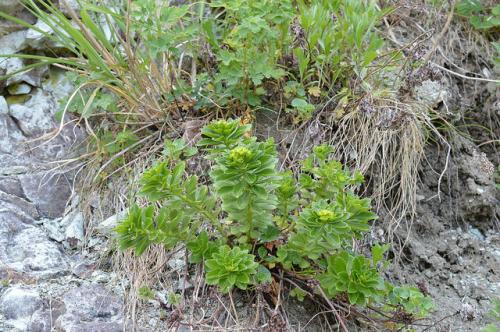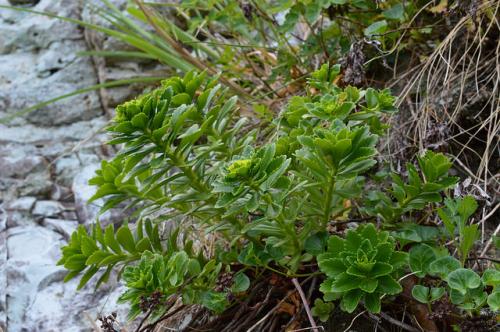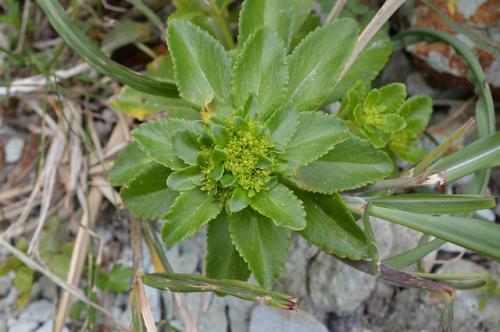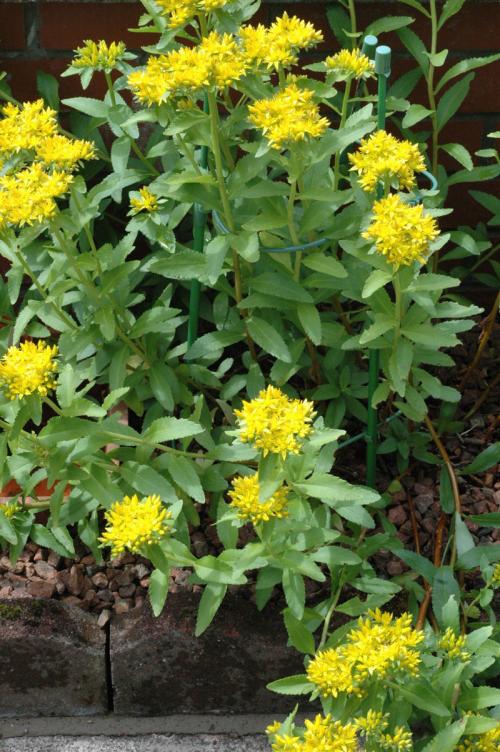AIZOON (L.) 't Hart, 1995
Synonyms :
Sedum aizoon L. (1753) / Aizopsis aizoon (L.) Grulich (1984)
Sedum aizoon var. aurantiacum hort. (s.a.)
Sedum aizoides Salm-Dyck (1834)
Sedum sajanense Pallas ex Ledebour (1843)
Sedum aizoon var. latifolium Maximowicz (1859) / Sedum aizoon fa. latifolium (Maximowicz) Y.C.Zhu (1989) / Phedimus aizoon var. latifolius (Maximowicz) H.Ohba & al. (2000)
Sedum aizoon fa. floribundum Miquel (1866)
Sedum maximowiczii Regel (1866) / Phedimus maximowiczii (Regel) 't Hart (1995) / Aizopsis maximowiczii (Regel) S.Gontcharova (1999)
Sedum pseudo-aizoon Debeaux (1877)
Sedum yantaiense Debeaux (1877)
Sedum aizoon fa. angustifolium Franchet (1883) / Sedum aizoon var. angustifolium (Franchet) Chu (1959).
Sedum aizoon var. scabrum Maximowicz (1884) / Phedimus aizoon var. scabrus (Maximowicz) H.Ohba & al.(2000)
Sedum aizoon var. floribundum Nakai (1911) / Phedimus aizoon var. floribundus (Nakai) H.Ohba (2001)
Sedum aizoon var. saxatilis Nakai (1911)
Sedum woodwardii N.E.Brown (1912)
Sedum hyperaizoon Komarov (1931)
Sedum austro-manshuricum Nakai & Kitagawa (1934) / Sedum aizoon var. austro-manshuricum (Nakai & Kitagawa) Kitagawa (1939)
Sedum aizoon var. obovatum Fröderström (1935)
Sedum selskianum var. glaberrimum Kitagawa (1936) / Sedum aizoon fa glaberrimum (Kitagawa) Kitagawa (1939)
Sedum selskianum var. glabrifolium Kitagawa (1936) / Sedum aizoon var. glabrifolium (Kitagawa) Kitagawa (1939) / Sedum aizoon fa glabrifolium (Kitagawa) Y.C.Zhu (1989)
Sedum aizoon var. yamatutae Kitagawa (1939) / Phedimus aizoon var. yamatutae Kitagawa) H.Ohba & al. (2000)
Sedum aizoon var. heterodontum Nakai (1949)
Sedum aizoon var. ramosum Uyeki & Sakata (1949)
Sedum kamtschaticum fa viviparum Takejiro Hashimoto (1975)
Sedum hsinganicum Y.C.Chu ex S.H.Fu & Y.H.Huang (1980) / Phedimus hsinganicus (Y.C.Chu ex S.H.Fu & Y.H.Huang) H.Ohba & al. (2000)
Sedum aizoon ssp. baicalense Peschkova (1994)
Subgenus Aizoon
Distribution : Russia (Siberia, and eastern of the Ural Mts.), Mongolia, China, Japan; dry sites, grassy slopes, shrub thickets, meadows, rocky streamsides and sandy cliffs; naturalized in northern Europe and the Baltic countries.
Description (according to 't Hart & Bleij IHSP, 2003) :
Perennial robust glabrous herbs with a large thick torulose and woody rootstock and erect stems to 80 cm long.
Leaves broadly ovate to narrowly oblanceolate or linear-lanceolate, (1-) 5 - 9 cm, obtuse, dentate to almost entire, glabrous or sometimes scabrid-papillose, short-petiolate.
Inflorescence terminal, 2.5 – 7.5 cm in diameter, flat.
Flowers 5- to 6-merous, sessile, sepals linear to lanceolate, obtuse, 3.5 - 6 mm, petals connate for up to 2 mm, oblong, rather long-mucronate, 7 - 9 mm, bright yellow, anthers yellow.
Cytology :
2n = 32, 33, 34, 48, 61, 64,78,80,84,85,88,93,94,95,96,97,102 (Amano 1990)
2n = 71-124 (Amano & Ohba 1992)
Ohba (1982b), Amano (1990) and Amano & Ohba (1992) distinguish 2 subspecies in Japan, ssp. aizoon and ssp. floribundum. They are separated by a small number of quantitive vegetative characters. Ssp. aizoon is larger and more uniform in all characters, whereas ssp. floribundum is generally smaller and comprises several morphologically distinct geographical races. Cytologically both taxa are extremely variable. The differences in chromosome numbers agree with the morphological variation to some extent. The larger ssp. aizoon is highly polyploid comprising an aneuploid series with 37 different chromosome numbers ranging from 2n = 71 to 2n = 124 (with 2n = 96 most frequent), whereas the smaller ssp.floribundum is tetraploid (2n = 32), hexaploid (2n = 48), or octoploid (2n = 64).
According to Fu (1980) Sedum hsinganicum is similar to S. aizoon var. latifolium, but differs by its 8-merous flowers and opposite leaves. The alleged floral characters, however, are largely at odds with an assignment of this taxon to Phedimus subgenus Aizoon. As yet we have no clue to the proper systematic position of this questionable species. It is without comment recognized as a separate species and at the same time placed in Phedimus by Ohba & al. (2000).
The same authors recognize 3 varieties for their treatment of P. aizoon for the Flora of China.
Plants in habitat, Oga Peninsula, Akita, north-western Honshu :



Photos Mizuho Onodera
Plants in cultivation :

Photo Ray Stephenson